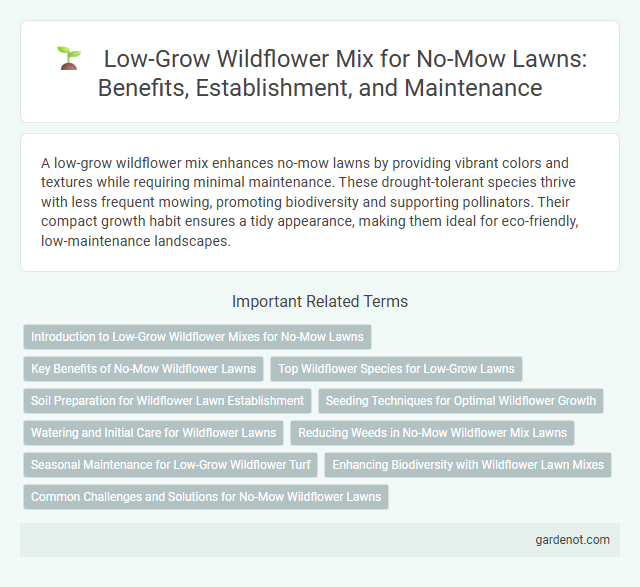A low-grow wildflower mix enhances no-mow lawns by providing vibrant colors and textures while requiring minimal maintenance. These drought-tolerant species thrive with less frequent mowing, promoting biodiversity and supporting pollinators. Their compact growth habit ensures a tidy appearance, making them ideal for eco-friendly, low-maintenance landscapes.
Introduction to Low-Grow Wildflower Mixes for No-Mow Lawns
Low-grow wildflower mixes offer an eco-friendly alternative for no-mow lawns by featuring compact, slow-growing species that require minimal maintenance. These mixes typically include native plants such as creeping thyme, moss phlox, and chamomile, which provide vibrant blooms and support local pollinators. Incorporating a low-grow wildflower mix enhances biodiversity while reducing water usage and eliminating the need for frequent mowing.
Key Benefits of No-Mow Wildflower Lawns
Low-grow wildflower mixes create vibrant, low-maintenance no-mow lawns that support biodiversity by attracting pollinators such as bees and butterflies. These mixes reduce the need for frequent mowing, lowering carbon emissions and saving time and resources. Their deep-rooted plants improve soil health and water retention, making them an eco-friendly alternative to traditional grass lawns.
Top Wildflower Species for Low-Grow Lawns
Top wildflower species for low-grow no-mow lawns include creeping thyme, bird's-foot trefoil, and self-heal, which thrive with minimal maintenance and provide vibrant color and ground coverage. These species promote biodiversity, support pollinators, and require infrequent trimming, making them ideal for eco-friendly landscaping. Their low height and spreading growth habit contribute to a durable, drought-tolerant lawn alternative that reduces mowing frequency and water usage.
Soil Preparation for Wildflower Lawn Establishment
For successful soil preparation in establishing a low-grow wildflower mix, begin with thorough soil testing to determine pH and nutrient levels, aiming for a slightly acidic to neutral pH of 6.0 to 7.0. Remove existing turf and weeds by solarization or herbicide application, then lightly till the soil to create a crumbly, fine seedbed that promotes seed-to-soil contact. Avoid excessive fertilization, as wildflowers thrive in low-nutrient soils, which encourages robust root development and diverse plant growth in no-mow lawns.
Seeding Techniques for Optimal Wildflower Growth
Seeding techniques for a low-grow wildflower mix in a no-mow lawn include preparing the soil by removing debris and lightly tilling to ensure good seed-to-soil contact. Evenly broadcast the seeds at the recommended rate, followed by gentle raking or roller pressing to embed seeds without burying them too deep. Regular watering after seeding supports germination and establishment of wildflowers with minimal disturbance to promote optimal growth.
Watering and Initial Care for Wildflower Lawns
Low-grow wildflower mixes require minimal watering once established but need consistent moisture during the initial 3-4 weeks after sowing to encourage strong root development. Avoid overwatering to prevent seed rot and fungal issues, applying light, frequent waterings instead of heavy soaking. Initial care includes keeping the soil moist and protecting the area from foot traffic and mowing until wildflowers reach about 6 inches in height.
Reducing Weeds in No-Mow Wildflower Mix Lawns
Low-grow wildflower mixes in no-mow lawns significantly reduce weed proliferation by creating dense, diverse plant coverage that competes effectively against invasive species. These specialized seed blends often include native grasses and wildflowers that establish quickly, suppressing weed growth through natural ground shading and nutrient competition. Utilizing low-grow wildflower mixes enhances lawn health while minimizing maintenance and chemical herbicide use.
Seasonal Maintenance for Low-Grow Wildflower Turf
Seasonal maintenance for low-grow wildflower turf involves minimal mowing, typically once or twice a year to encourage healthy growth and seed dispersal. Cutting the turf in late autumn or early spring helps remove dead foliage while preserving plant diversity and soil health. Avoiding frequent mowing promotes vibrant blooms and supports pollinators throughout the growing season.
Enhancing Biodiversity with Wildflower Lawn Mixes
Low-grow wildflower mixes create a vibrant no-mow lawn that supports pollinators and increases local biodiversity by providing essential habitats for bees, butterflies, and other beneficial insects. These mixes often include native species like creeping thyme, white clover, and self-heal, which require minimal maintenance and tolerate mowing infrequently. By establishing a wildflower lawn, homeowners promote ecological balance, improve soil health, and contribute to urban wildlife corridors, making it a sustainable alternative to traditional turfgrass.
Common Challenges and Solutions for No-Mow Wildflower Lawns
No-mow wildflower lawns with low-grow mixes often face challenges such as uneven germination, weed invasion, and inconsistent flowering periods. Solutions include careful seed selection for native species, proper soil preparation to reduce competition, and targeted spot weeding during the initial growth phase. Regular monitoring and adjusting mowing frequency to mimic natural disturbances can enhance plant diversity and lawn health.
Low-grow wildflower mix Infographic

 gardenot.com
gardenot.com